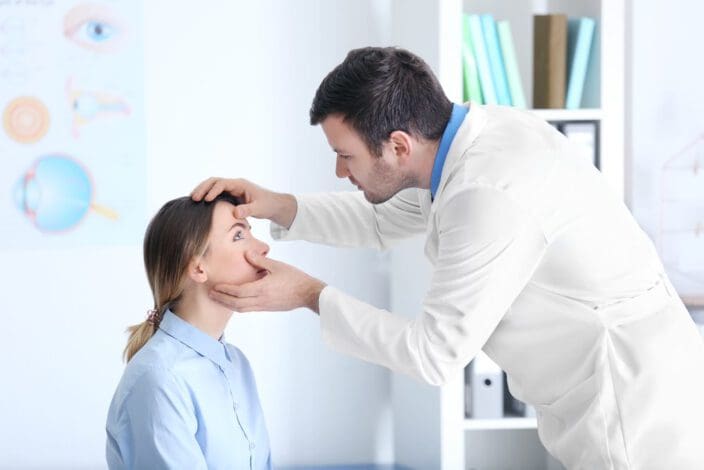Further Reading
Jaundice of the Eyes: Treatments That Actually Work
Home / Vision Education Center /
Last Updated:
You’ve probably heard the phrase “the whites of your eyes.” The tissue that surrounds your iris should be a milky white, but sometimes, it can turn yellow. The condition is called jaundice, and it develops when bilirubin builds up in the blood.
Table of Contents
Seeing yellow in your eyes can be alarming, and you are right to be concerned. Jaundice is a symptom of a variety of conditions, including viral infections, gallstones, and pancreatitis. Yellowing of the eyes is the first symptom of disease you might notice when you have these issues.
When your eyes turn yellow, you must visit a doctor right away. You will need testing to determine what is causing the problem. The treatment you need, and the length of that care, depends on what’s causing your jaundice. Babies can also get jaundice. In fact, the condition is very common in infants. Doctors use different therapies, including light treatments, to help small babies recover from jaundice.
The Role of Bilirubin

Jaundice, or yellowing of the eyes and skin, is caused by a buildup of bilirubin in the blood.
Your body produces bilirubin naturally, says Nemours. Red blood cells grow less efficient with age, and they are recycled within the body via bilirubin produced by the liver. Normally, it leaves the body through the bowels. That is why normal feces have a brown color.
You deserve clear vision. We can help.
With 135+ locations and over 2.5 million procedures performed, our board-certified eye surgeons deliver results you can trust. Your journey to better vision starts here.
People with jaundice are not producing or recycling cells at a fast rate. As the system breaks down, bilirubin continues to circulate in the bloodstream, and the distinctive color of that material begins to show in the skin and eyes.
For people with dark skin, jaundice is easiest to spot in the whites of the eyes. But anyone may notice the issue with a simple skin press. If you push on the skin and let the blood return, your tissues may look yellow as they refill with blood. It’s best to do this test in natural sunlight, as fluorescent lights can give your skin a yellow cast.
What Does Jaundice Mean?
You may think of jaundice as a standalone disease with one cause and one cure. In reality, it’s a symptom of an underlying disease.
Researchers say that jaundice in adults often develops so slowly that people do not notice it. And it’s easiest to spot in the whites of the eyes. Your eye doctor may notice the discoloration when you are sitting for an eye exam, and you may not even know that something is amiss within your body.
The Cleveland Clinic says the body has three distinct bilirubin phases, and jaundice can develop from a disruption of one of them. You may develop yellowing in the eyes due to a problem with bilirubin.
- Pre-production: Some forms of jaundice develop due to bruises or hematomas. The body just can’t clean up the damage fast enough. You may also develop jaundice due to anemia if your cells are removed too quickly when they are still functional.
- Production: Viruses, alcohol abuse, autoimmune disorders, and medication toxicity can all interfere with your body’s ability to make bilirubin.
- Removal: Gallstones, inflammation, cancer, and tumors can block the ducts your body uses to remove bilirubin.
The treatment you need to return the white to your eyes depends on the cause of your jaundice. Testing is critical, as it gives your doctor the information needed to help you recover.
You deserve clear vision. We can help.
With 135+ locations and over 2.5 million procedures performed, our board-certified eye surgeons deliver results you can trust. Your journey to better vision starts here.
How Your Doctor Diagnoses Jaundice

Your doctor must get to the cause of your eye yellowing. Since jaundice can stem from so many causes, it’s not uncommon for people to go through a battery of tests with their doctors to find answers.
Mount Sinai says doctors may use these methods to diagnose the cause of jaundice:
- Cholangiopancreatography
- Cholesterol screening
- Complete blood count
- CT scan
- Hepatitis screening
- Liver biopsy
- Liver function test
- Ultrasound
This is a long list of tests, and many of them have intimidating-sounding names. Do not be afraid to ask your doctor what each test can highlight, and ensure you understand what the results mean.
Your doctor may also use a bilirubin blood test to diagnose your jaundice. This test, according to the U.S. National Library of Medicine, involves taking a small sample of your blood and determining how much bilirubin is included. If the results are high, it often indicates a problem with your liver health.
People with jaundice want to get better fast, and it’s reasonable to wonder what treatments you will need and how long they will last. Unfortunately, since jaundice stems from so many different conditions, it’s impossible to make predictions. The care you will need depends on your test results.
Stay connected with your doctor and follow your treatment plan carefully. Together, you can help your body to heal, so you will have white eyes and healthy organs once more.
Newborn Jaundice: A Different Course of Treatment

Until this point, we’ve been talking exclusively about adults with yellowing eyes and skin. But babies can, and often do, get jaundice. When it happens, the care they need is different from the treatment given to their adult counterparts.
The American Liver Foundation says most newborns develop jaundice, and in most cases, it’s mild. The condition is caused by underdeveloped organs. Babies rely on their mothers’ bodies to eliminate toxins, and after birth, they need to use their own. Sometimes, the new organs just are not ready yet, and they need a week or two to get up and running.
The American Academy of Pediatrics says babies can also develop jaundice due to:
- Premature birth. Babies born too early do not have the time to grow strong and healthy organs. They can develop jaundice due to underdevelopment.
- Poor nutrition. Babies rely on a constant supply of milk to flush toxins out of the body. When babies do not eat enough, the system breaks down.
- Breastfeeding. Breast milk can cause a spike in bilirubin levels, and in some babies, it makes passing bilirubin difficult.
Parents of babies with jaundice must work closely with their doctors. Sometimes, babies get better on their own, and they do not need treatment at all. But if jaundice is significant and it remains untreated, it can cause lifelong damage to a baby’s delicate system.
When jaundice is severe or does not resolve, doctors use a special form of light. The University of Michigan explains that new forms of phototherapy involve a blanket that covers your baby in therapeutic light. The blanket sits right next to your baby’s skin, and during treatment, it helps prompt the body to filter toxins. Your baby may not even notice that the therapy is happening. But as treatment progresses, you should see your baby’s skin color improve.
Whether your doctor recommends watching for improvement or using a form of light therapy, it’s crucial to follow instructions and keep your appointments. Do that, and you will give your baby the best chance for a full recovery.
You deserve clear vision. We can help.
With 135+ locations and over 2.5 million procedures performed, our board-certified eye surgeons deliver results you can trust. Your journey to better vision starts here.
References
- Jaundice in Newborns. (April 2019). Nemours.
- Jaundice and the Eyes. (November 2017). Review in Optometry.
- Adult Jaundice. (July 2018). Cleveland Clinic.
- Jaundice. Mount Sinai.
- Bilirubin Blood Test. U.S. National Library of Medicine.
- Jaundice in Newborns. American Liver Foundation.
- Infant Jaundice. (August 2018). American Academy of Family Physicians.
- Your Baby, Jaundice, and Phototherapy. (May 2005). University of Michigan.
This content is for informational purposes only. It may have been reviewed by a licensed physician, but is not intended to serve as a substitute for professional medical advice. Always consult your healthcare provider with any health concerns. For more, read our Privacy Policy and Editorial Policy.